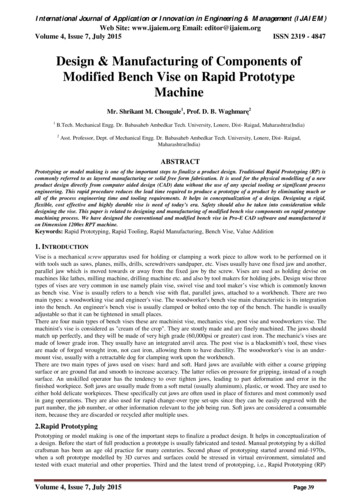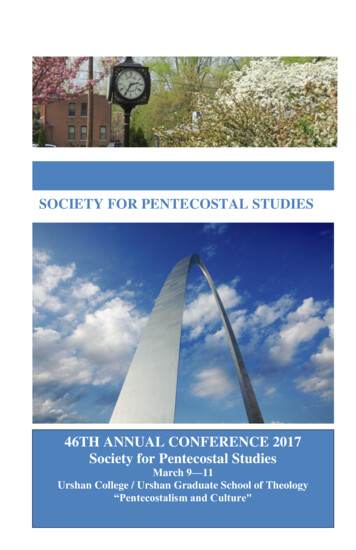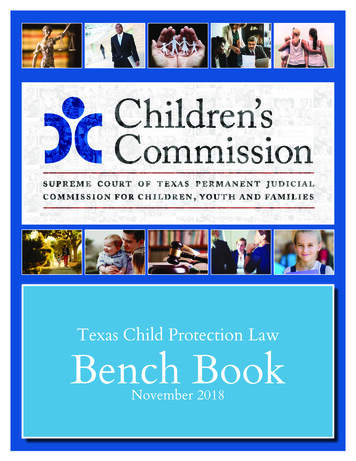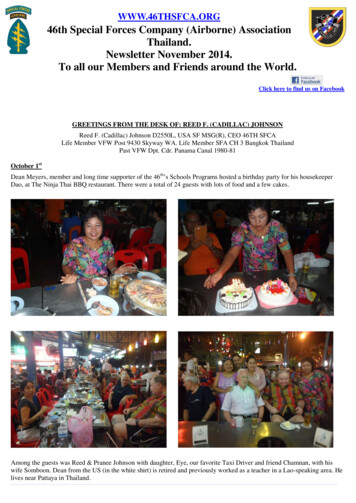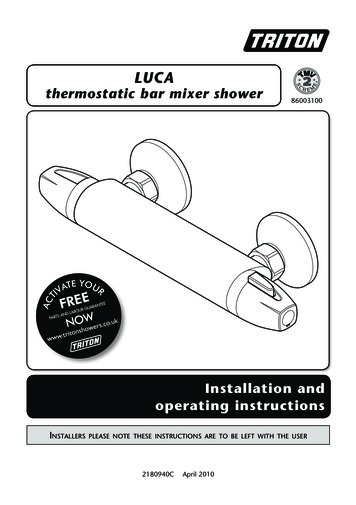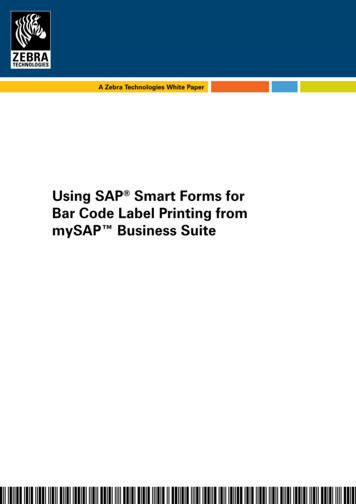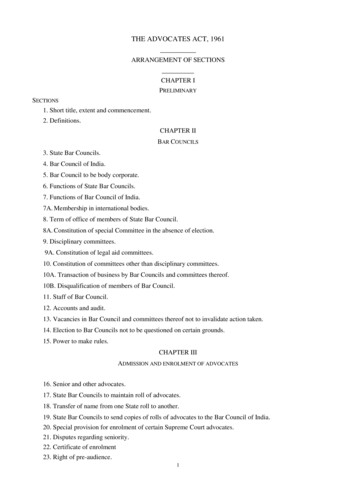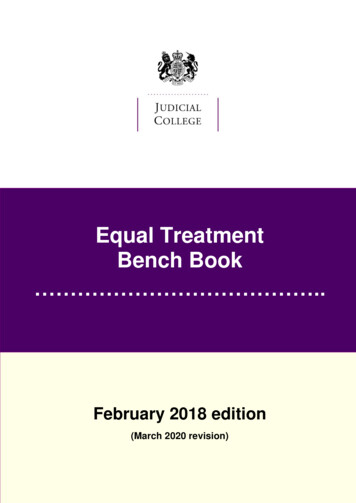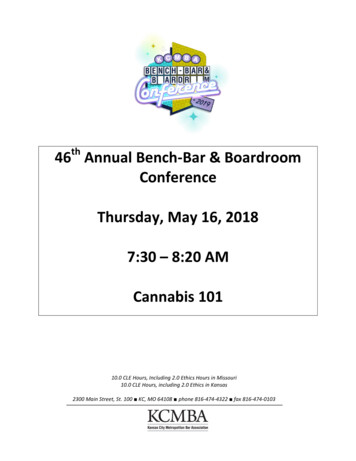
Transcription
46th Annual Bench-Bar & BoardroomConferenceThursday, May 16, 20187:30 – 8:20 AMCannabis 10110.0 CLE Hours, Including 2.0 Ethics Hours in Missouri10.0 CLE Hours, including 2.0 Ethics in Kansas2300 Main Street, St. 100 KC, MO 64108 phone 816-474-4322 fax 816-474-0103
Aubrey Gann-Redmon, AGR Legal Services, LLCEDUCATIONAubrey graduated summa cum laude from Avila University with a Bachelor of Arts degree in Sociology.She went on to obtain her Juris Doctorate degree from University of Missouri Kansas City School of Law,where she received the Order of the Barrister’s honor for excellence in trial advocacy. Aubrey alsoserved on the staff of the ABA journal Urban Lawyer, and received the CALI Excellence in Learning Awardfor her academic work in the areas of Criminal Law and Gender & Justice. While in law school, Aubreyheld internships where she worked on federal death penalty appeals, complex probate and trustlitigation cases, and personal injury lawsuits.EXPERIENCEAfter law school, Aubrey was an associate at a boutique plaintiff’s personal injury firm where sheworked on personal injury, employment discrimination, and social security disability cases. Currently,her practice focuses exclusively on cannabis law, as well as litigating estate, trust, and probate cases,with experience in both defending and prosecuting legal malpractice actions in the area of probate.COMMUNITY INVOLVEMENT & ACCOLADESSince starting AGR Legal Services, Aubrey has written and published numerous articles and taughtclasses and CLEs on probate and legal research techniques. Aubrey has also taught as an adjunctprofessor in the criminology department at Avila University. She served on the Kansas City MetropolitanBar Association Continuing Legal Education Advisory Committee in 2015 and 2016, and in the past, hasserved as the Vice Chair for the Solo & Small Firm Committee. Aubrey is also active in the Association forWomen Lawyers, where she has been involved in the AWL Foundation’s Connections MentorshipProgram since 2009, serving as a mentee from 2009-2013, and then as a mentor from 2014 through thepresent.She was also involved in the Foundation’s First Annual charity 5k committee. She is also a member ofthe Brain Injury Association of Kansas and Greater Kansas City. Aubrey was also voted SuperLawyersRising Star in 2013, 2014, 2015, 2016, and 2017 and Kansas City Business Journal’s Best of the Bar 2014,2015, and 2016 by her peers.
Outside of her practice, Aubrey supports her community through charitable giving to Lee’s SummitMeals on Wheels. Aubrey is married to Chet Redmon, a local artisan who owns CR Custom Ironworks,LLC, a shop that designs and builds custom ironwork sculptures and functional installations.
CANNABIS 101:The Who, What, When, Where, Whys, and Hows of Amendment 2’simpact on Medical Marijuana in Missouri
WHAT is cannabis? Cannabis is a plant used for a number of purposes: Hemp – cannabis that has less than 0.03% THC (the psychoactive component) Used for rope, fiber, clothing, etc. Used for hemp-derived CBD (cannabidinol), which has medicine purposes but is notpsychoactive Legal federally per passage of the Farm Bill, Dec. 2018 Currently FDA looking at CBD/Hemp as a food additiveCannabis Indica – strains grow short, known for calming effects, help with pain & sleep Setiva – strains grow tall, known for helping with focus, energy, and creativity Federally ILLEGAL
WHAT is cannabis, continued Experienced cultivators can: Get 1-2 lbs of flower per plant Amendment 2 permits cultivators to grow up to 2800 plants in 30,000 sf of floweringcanopy space High quality medical grade cannabis goes for up to 1,500/lb of flower Some strains have THC limits up to 30%, with the current average around 20-23%Turpenes – do not contain THC Turpenes are chemicals found on all plants, and help to add taste, smell, and alter the“high” of cannabis to induce calm, reduce paranoia, and intensify highs Often referred to as “dank” – the distinctive scent of cannabis Being added to vape cartridges to enhance flavor, aroma, and/or alter the effects of thecannabis (usually to reduce paranoia, anxiety, or to “uplift”)
WHAT’S in a word? The lingo Flower – refers to the “buds” or “nuggets” that grow from the stem and containthe sticky potent parts of the plant Kief – cannabis crystals, also known as resinous trichomes, which can be extractedand made into concentrates Concentrates or extracts – highly concentrated THC derived from the flower andother parts of the plant, often used with special vape pens or dabbing Dabs, dabbing – means smoking the vapor or smoke of highly concentrated cannabisin the form of concentrate, oil extract, or wax – heavier dose potential andimmediate effect for pain sufferers Gummies – a type of edible ranging in dosage from an avg of 10mg to 25mg, which10mg generally considered a “starter” dose
WHAT’S in a word, continued The lingo: Dispensary – where cannabis is sold, legally, to medical patient in a state wherelegal or to adults over 21 in fully legal states Bud-Tender – the person who will help the patient make a decision as to the typeof cannabis product to buy at a dispensary Manufacturer – an operation that takes the whole plant, extracts the oils andalkaloids from the plant, and makes them into foods, beverages, candies, vapecartridge oils, and extracts like wax, shatter, hash oil, etc. Cultivator – an operation that grow cannabis, usually under the supervision of amaster grower Testing Lab – where the cannabis products are tested and rated for consumption Cannabis – not marijuana because .
WHY Cannabis? A few stats to start Marijuana is a term associated with Prohibition and the trend is away fromProhibition and towards full legalization Fastest growing demographic of cannabis users – 55 years and older Missouri is the 32nd State to legalize in some way Fully ILLEGAL in 14 states, including Kansas Fully LEGAL in 11 jurisdictions, including Colorado and Washington DC Legal in 21 countries internationally, including Canada, Australia, & Mexico Numerous medical applications, from acne to traumatic brain injuries Studies show may be safer to consume than alcohol
WHY Cannabis? because “marijuana” is racial slang that was used to encourage prohibition Prior to Prohibition: Hemp was one of the top three crops at the time of the nation’s founding Cannabis was featured on the 10 bill until 1900 Medicinal properties introduced to the West circa 1839 for pain, muscle spasms viaWilliam O'Shaughnessy, an English botanist working in Calcutta Widely available in the US in pharmacies by 1850s By 1905, US Dept of Ag had printed materials on cannabis as administered bypharmacies in the US, with most states not restricting its use By 1880s there were at least 500 hash bars in NYC alone, usually patronized by theupper-classes in city society
WHY Cannabis continued But Prohibition begins: 1906 Pure Food & Drug Act: patented medicines with “secret” ingredientsregulated, cannabis now required to be labeled Cannabis labeled as a “narcotic poison” and use was permitted only uponprescription and dispensed by a pharmacy CA was the first state to jump in and regulate, with the first raid occurring in 1914in Sonoratown in Los Angeles 1920 – Federal prohibition of alcohol Tension with border states and cannabis regulation because of the influx ofHispanic migrant farm workers, who would smoke cannabis to relax after work Uniform State Narcotic Drug Act (1925-32) – encouraged states to regulate cannabisand assist feds in policing trafficking
WHY Cannabis, continued International Opium Convention, 1925, international push to curb the IndianHemp trade Fed. Bur. Of Narcotics – 1930 – Harry Anslinger Traveled world early in career to research the opium trade and opined thatcannabis was not a substance of concern Headed the Dept. of Prohibition for alcohol When alcohol Prohibition ended, his job was in jeopardy and he began targetingcannabis, claiming it to cause violence and arguing Treasury should get involveddue to loss of revenue since it wasn’t being taxed 29 of 30 AMA pharmacists disagreed with Anslinger’s new claims on the dangers ofcannabis Began a huge public relation campaign in papers with help of William Hurst toconflate the “marijuana problem” with the immigrants coming in from thesouthern border & Caribbean and with the Jazz music movement
WHY Cannabis, continued Note: around the same time, both Mellon (Treasury Sec) and DuPont hadfinancial interests in joining the Prohibition push; Mellon had large financialinvestments in nylon and DuPont was developing synthetic fibers, incl. nylon Marihuana Tax Act of 1937 Now, cannabis has been replaced with the racially charged slang, “marijuana” Imposed a steep tax on transfer of cannabis, tax paid by pharmacists Farmers encouraged to obtain stamps during WWII to increase hemp production
WHY Cannabis, continued Mandatory sentencing began in 1952, and again in 1956 (mandatory minimumof 2-10 years for possession) Controlled Substances Act, 1970 Leary v. United States, 395 U.S. 6 (1969) – Marihuana Tax Act unconstitutionalbecause it required self-incrimination in violation of 5th Amendment Repealed the Tax Act, repealed mandatory sentencing, but listed cannabis as aSchedule I narcotic (no medical purpose whatsoever, along with LSD, heroin, andpeyote)1998 – CA voters approve Prop 215, legalizing medical cannabis Let the raids begin United States v. Oakland Cannabis Buyers' Cooperative, 532U.S. 483 (2001) – medical necessity (allowed under CA law for possession and use)is preempted by federal law
WHY Cannabis, continued Gonzales v. Raich (previously Ashcroft v. Raich), 545 U.S. 1 (2005): by now, CAis one of FOURTEEN states that allows medical cannabis, but raided andprosecuted her from home-growing her own under doctor’s orders; arguedthat home grown plants effect interstate commerce because Congressregulates agriculture: “The parallel concern making it appropriate to includemarijuana grown for home consumption in the CSA is the likelihood that thehigh demand in the interstate market will draw such marijuana into thatmarket.” (Justices Souter, Stevens, Kennedy, Ginsburg, Breyer & Scalia) Cole Memorandum – issued under Obama, DOJ not to use budget to enforceCSA in states where cannabis is legal medicinally or for adult use Rescinded by Sessions, but Rohrabacher–Farr amendment (2014) discouragesspending money on federal raids in legal states and is still in effect
Meanwhile, while all that washappening . Shafer Commission (1972) – after the passage of the CSA, Congressionallycommissioned to study cannabis and found it non-threatening, recommendingreduction/elimination of criminal penalties Compassionate IND program (1978) – the Federal government actually grewand distributed medical cannabis to Investigational New Drug patients whoapplied and were granted approval, despite classification as a CSA Sched. Inarcotic (with NO medicinal properties!) and held patents on cannabidinol usein medical applications! Closed to new patients under Bush in 1992 after aninflux of applications from AIDS patients. Currently, 2 patients remain underthis program. 1988 - DEA Chief Administrative Law Judge Francis L. Young ruled in favor ofmoving cannabis to a Schedule II classification, finding that "Marijuana, in itsnatural form, is one of the safest therapeutically active substances known toman.”
The WHO and WHY behindrecommendations Conant v. Walters, 309 F.3d 629 (9th Cir. 2002) – doctors in legal states exemptfrom federal prosecution for recommending cannabis, but cannot prescribe it (dueto CSA Sched. I classification, no Sched. I drugs have medicinal uses, so cannot beprescribed) SO CALL IT CANNABIS, even if governments refuse to leave the term “marijuana”behind So, as for Amendment 2 in Missouri: Physicians licensed in Missouri (MD, DO, or Psych) may recommend cannabis to a patientwho qualifies for a certifying condition Recommendations are HIPAA protected – the State won’t know why the patient wascertified, only that a doctor recommended cannabis for one of the conditions A2 covers Recommendations must be dated within 30 days of the patient’s application for amedical card or a caregiver’s application on behalf of the certified patient
The WHO and WHY behindrecommendations, continued So patients may be certified for one of the following: Cancer Epilepsy Glaucoma Intractable migraines Chronic medical condition resulting in persistent pain and/or muscle spasms (MS,Parkinson’s, Tourette’s, etc.) Debilitating psychiatric disorders like PTSD HIV/AIDS Chronic medical conditions that would result in prescribing drugs that could behabit-forming if cannabis is deemed a safer alternative (i.e., to reduce opiodaddiction)
The WHO and WHY behindrecommendations, continued Any terminal illness ANY OTHER chronic condition that, in the doctor’s judgment, would benefit fromthe therapeutic use of cannabis, including but not limited to, Hep C, ALS, IBS,Crohn’s, Huntington’s, autism, Alzheimer’s, sickle cell Caregivers must be 21 or older, and cannot apply to be a caregiver for morethan 3 certified patients Patients and caregivers can apply to grow up to 6 plants per certified patientin a secured location within their residence Caregiver status implies the ability to possess and transport cannabis forpatients Out of state patient cards are accepted in Missouri – cannabis tourism?
WHEN? June 4, 2019 – Dept. of Health & Senior Services will finalize regulations June 4, 2019 – DHSS will put ALL applications online July 4, 2019 – DHSS will begin accepting patient, caregiver, and home growapplications August 3, 2019 – DHSS will begin accepting applications for business licenses &certifications (dispensaries, testing labs, transportation facilities, cultivators,manufacturing facilities, and more) August 4, 2019 – DHSS will begin issuing patient, caregiver, and home growcards December 31, 2019 – DHSS will issue the first business licenses & certifications EST – Mar/Apr 2020 – the first dispensaries may have product to sell in MO
WHERE? Missouri – statewide Dispensaries – minimum of 192 licenses to be approved first round, 24 perCongressional district Manufacturers – minimum of 82 /- licenses Cultivators – minimum of 63 licenses (numbers vary depending on source) Testing Labs – minimum of 2 licenses What cities? A2 – cities cannot prohibit cannabis business, but can regulate the time, place, andmanner No less than 1,000 feet away from schools or churches unless variance is obtained
HOW? Applications for businesses will be capped at 500 pages and include thingslike: Business plans and SOPs Security plans and diagrams Criminal background checks of owners Copies of lease agreements and diagrams of premises, or if purchased, the realestate documents Resumes and experience of the “team” Business entity documents, such as operating agreements, bylaws, shareholderagreements, and the like
HOW? Continued Merit-based scoring system: Once the applications for the businesses are received, they will be segregated outby congressional district Each will be scored, blind, with no consideration given to race, color, gender, etc. Points are awarded for such things as plans for increasing access/affordability tothose with low income, community and economic impact, and experience in theindustry Extra points are awarded to dispensaries more than 25 miles away from the nextnearest dispensary and the top scoring dispensary in the district area Might be issues with constitutionality with system if found to be arbitrary andcapricious (suits in other states on denied applications) Might have constitutional challenges re: requirement of Missouri residency
HOW does this effect my clients? If stopped by law enforcement: Patients can produce a patient card or equivalent from any jurisdiction (such asCalifornia) and be immune from prosecution (Sec. 5.1, page 10) Card-holding patients can possess up to 4 ounces/30 days Allows possession of 6 plants per patient, 12 plants per householdIs cannabis still a controlled substance? A2 removed cannabis as a Sched. I controlled substance from RSMo. Ch. 195 sinceit is now deemed to have a medical purpose/use in Missouri Ch. 195’s exceptions to prescribing haven’t been revised yet, and cannabis cannotbe prescribed, and its not a Sched. V OTC drug – so what is it? II? III? Or IV? Many criminal ordinances and statutes refer to “controlled substances” – loophole?
HOW does this affect me as a lawyer? A2 expressly protects lawyers assisting clients in the industry and owningcannabis businesses Other states have expressly issued formal ethics opinions protecting attorneyswho are certified to use cannabis as patients (see Colorado for an example inResources Section) This will affect every area of law (some examples): States are beginning to ban or limit ability of some employers to test new hires Missouri’s worker’s compensation statutes would not necessarily prohibitcompensation for work-related injuries if an employee with a validrecommendation was not shown to be impaired on the job Patients won’t automatically be deemed unfit parents if they use cannabis andhave a valid medical card Recent studies show that THC levels are hard to link to DUIs and field sobriety testsmay be a better indicator
“QUESTIONS?”Aubrey Gann-Redmon, Esq.AGR Legal Services, LLCwww.agrlegalservices.comLicensed in Missouri, Kansas, and Colorado
Resources State-By-State Legalization Status Map and Links: https://disa.com/map-ofmarijuana-legality-by-state Legalization com/article/cannabis-legalization-worldmap/ Top 71 Uses for medical cannabis: ses-of-cannabis Cannabis safer than alcohol, PMC4311234/ Cannabis v. alcohol: hich-worse-health-2017-11
Resources, continued Missouri Amendment ions/2018-051.pdf Missouri DHSS Medical Marijuana a/index.php Is Amendment 2 opinion-is-missouris-amendment-2constitutional/ Colorado ethics opinion – lawyer’s use of medical sitory/ethicsOpinions/FormalEthicsOpinion 124 2014.pdf
10.0 CLE Hours, Including 2.0 Ethics Hours in Missouri 10.0 CLE Hours, including 2.0 Ethics in Kansas 2300 Main Street, St. 100 KC, MO 64108 phone 816-474-4322 fax 816-474-0103 46th Annual Bench-Bar & Boardroom Conference Thursday, May 16, 2018
